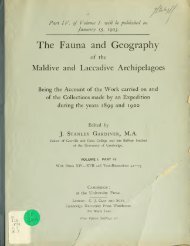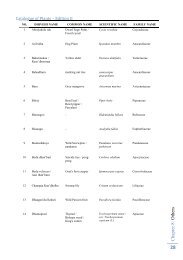Download - WordPress – www.wordpress.com
Download - WordPress – www.wordpress.com
Download - WordPress – www.wordpress.com
Create successful ePaper yourself
Turn your PDF publications into a flip-book with our unique Google optimized e-Paper software.
THE ENTEROPNEUSTA. 637its dermal pits and median gonads, it exhibits structural differences sufficient to separateit at once from Sp. porosa and Sp. alba, the only two species of this genus hitherto described.Willeyia bisulcata, nov. gen., n. sp. (PL XXXVIII. figs. 14, 23; PI. XXXIX. fig. 29;PI. XLI. figs. 9, 10; PL XLII. figs. 12—16).Locality, etc. This species was fairly abundant at Zanzibar, whence portions of twospecimens were brought back by Mr Crossland. They were obtained by digging in mudon which Zostera was growing atlow-water mark.External features. To judge from the fragments the length of this species must inthe entire state be considerable. The proboscis is about double the length of the collarand is marked both dorsally and ventrally by a deep median gi-oove (PI. XXXVIII. fig. 14).Its width is somewhat greater than its dorso-ventral depth. The collar is long and issomewhat broader behind than in front. Near its posterior end there is a well-markedcircular groove. In one of the two specimens available, which was somewhat larger thanthe other, the length of the proboscis was 14 mm., that of the collar 7 mm. The averagebreadth of both was about 4 mm. The branchial region and trunk have each a breadthsomewhat less. In the specimen above alluded to some 32 mm. of the branchial regionwere still attached to the collar. No external liver saccules were visible on any of thefi-agments. Probably they are not present. No portion of the caudal region was preserved.With the exception of the proboscis, which is somewhat dorso-ventrally flattened, the wholebody of the worm is more or less cylindrical. When living the animal was of a uniformcream colour.Proboscis. The epithelium is high though almost destitute of glands. It shews a verydistinct layer of elongated nuclei about its middle and numerous small rounded nuclei in itsdeeper portion. The layer of nerve fibrils is very distinct and well developed throughoutthis region and rests on a fine but clearly marked basement-membrane. The circular musclelayer is strong, being nearly half as thick again as the nervous layer. The longitudinalmuscles are well-developed, filling the greater portion of the proboscis (PL XLII. fig. 12).The nervous layer is thickened in the grooves.The proboscis coelom consists of a right and a left cavity which are entirely separatethroughout. They are lined by a well-marked epithelium which is considerably thickenednear the middle line (PL XLII. fig. 12 and PL XXXIX. fig. 29). The two divisions of thecoelom are surrounded by a <strong>com</strong>mon layer of circular muscles (PL XLII. fig. 12). The leftdivision of the proboscis coelom <strong>com</strong>municates with the exterior by a large pore (PL XLI.fig. 9). The right division ends blindly. No dorsal septum is present but there is a wellmarkedventral septum, at the upper edge of which runs the ventral recurrent vessel ofthe proboscis (PL XLII. figs. 11 and 12, and PL XXXIX. fig. 29, vrv.). This septumsprings from almost the tip of the proboscis and does not be<strong>com</strong>e <strong>com</strong>plete until shortlybehind where the pericardium arises. Here the ventral vessel be<strong>com</strong>es connected with thevessels of the glomerulus. On either side of the middle line are found dorso-ventralmuscles, the dorsal ones being more marked than the ventral. Both converge towards thevermiform process of the stomochord where this structure is found (PL XXXIX. fig. 29).The stomochord exhibits a well-marked lumen throughout, both in its central portionand in the lateral diverticula. Anteriorly it is produced forwards as a vermiform processwhich is about | of the length of the rest of the stomochord (PL XLII. fig. 10).G. II. 82






